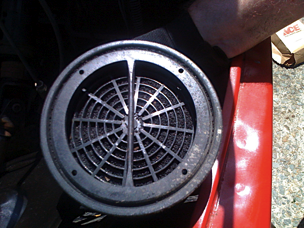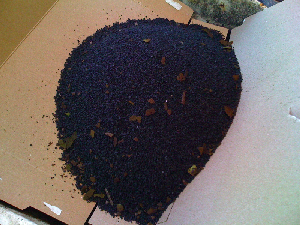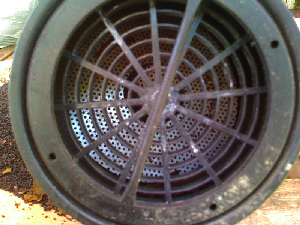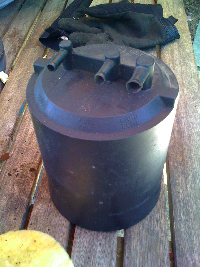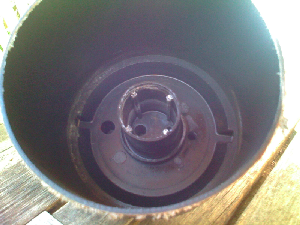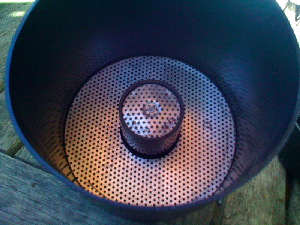My 1976 Jeep CJ-5
Find me on JeepForum
Vapor Recovery Charcoal Canister
What started out as a relatively minor little project, done primarily as a step in tracking down the source of a strong gasoline smell I was experiencing, turned into something a bit bigger when it became clear the original, 34 year old charcoal (original Mopar part number 3577 595) canister on the Jeep was falling apart internally.
Originally, I decided to examine the canister based on a suggestion I came across on the Jeep Forum boards in which someone stated the possibility that the carburetor was dumping gas into the canister and that's why I was smelling gas so strongly. (It turned out that the smell was coming from a cracked fuel line linking the hard line from the tank to the fuel pump - we could see gas dripping from the flexible line while the engine was running - replaced that foot of hose and all was well in that department.)
I pulled the canister out to check the replaceable filter on the bottom (Napa replacement part #2998 - Filter Breather). As you can see below, the original was filthy and in need of replacement. Dirty original filter on the left, new, clean filter on the right. Even though the replacement was a bit larger it tucked right in without difficulty.
One challenge I ran into was being unaware that the canister's charcoal was loose within the canister and retained only by the filter. The charcoal is in the form of tiny chunks—about the size of course ground cooking salt. When I first looked at the old filter, before removing it, I nudged it a bit to figure out how to pull it out (it just slips out, no need to unscrew anything) and then set the canister back into place for a moment while I picked up the new filter. Turns out, this was enough disturbance that the charcoal started pouring out of the canister all over the ground beneath the Jeep. I stopped it before more than about a cup of it came out, and I was able to recover most of that and pour it back into the canister. Seems odd that the only thing keeping that stuff in there is a filter that's easily pulled out. Here's a picture of the underside of the canister without the filter in place. If you look carefully you can see the tiny chunks of charcoal. Click on the image to see a larger version.
Once the new filter was in place I re-installed the canister and everything seemed to be in good shape.
However.
Within a day or two I was noticing that the Jeep would no longer idle, stumbled on acceleration, and was just generally running a bit rough when compared to before this whole adventure began. After much more research on the Jeep Forum site, along with reading about someone else's experience with their canister on their Wagoneer, I decided to look again at mine to see if this was the cause of the problems.
My suspicions were two-fold: 1) that a vacuum diaphragm in the canister had failed - leading to an ongoing vacuum leak causing the symptoms I was seeing; and 2) the possibility that some of the charcoal from the canister may have somehow found its way into the carb itself - perhaps clogging the idle jet.
First order of business was to look again at how the entire thing was set up, how it functions, etc. I read what little there is about the canister in my 1976 Factory Service Manual:
However.
Within a day or two I was noticing that the Jeep would no longer idle, stumbled on acceleration, and was just generally running a bit rough when compared to before this whole adventure began. After much more research on the Jeep Forum site, along with reading about someone else's experience with their canister on their Wagoneer, I decided to look again at mine to see if this was the cause of the problems.
My suspicions were two-fold: 1) that a vacuum diaphragm in the canister had failed - leading to an ongoing vacuum leak causing the symptoms I was seeing; and 2) the possibility that some of the charcoal from the canister may have somehow found its way into the carb itself - perhaps clogging the idle jet.
First order of business was to look again at how the entire thing was set up, how it functions, etc. I read what little there is about the canister in my 1976 Factory Service Manual:
"All YF carburetors have an external fuel bowl pressure vent. Excess bowl pressure is vented from the carburetor to the fuel vapor storage canister. An aluminum wafer, located inside the air horn, is normally seated. When pressure within the fuel bowl becomes excessive, the wafer unseats and pressure is vented through a passage in the air horn. A hose connected to the air horn vent passage sends the excess pressure and fuel vapor to the fuel vapor storage canister."
Additionally, the FSM states that:
"The fuel-resistant nylon body of the canister contains activated charcoal granules which absorb and store the fuel tank vapors until they are drawn into the intake manifold through the carburetor air cleaner."
Basically, what this means is that: 1) there is no diaphragm within the canister that could fail; and 2) hopefully, there is no way any of the charcoal making its way up into the ports at the top of the canister (bypassing the internal filters) could make its way into the carb itself, since everything is vented to the air cleaner and filtered there. To confirm all this I disassembled the canister.
What I found upon emptying all of the charcoal from the canister was the presence of a thin metal grate at the top of the canister, shaped like a donut. The shape is due to the fact that there's a small cylinder about the size of a D-sized battery projecting down into the canister in the middle. This also had a metal grate about the size of a half-dollar coin. I note that the holes in these two metal grates are larger than the charcoal granules. I.e., if turned upside down the charcoal can pass through these grates. To prevent this, the grates originally had a thin foam rubber filter attached to them. When I emptied the canister the remains of this foam rubber filter came out as well - so damaged by age that each piece I picked out of the charcoal pile simply turned to dust in my fingers. I could still see a few bits attached to the metal grates (which you may be able to see if you look closely at the larger version of the image on the right above). Additionally, when I pulled the hoses from the three ports there were bits of charcoal there which fell out. Clearly it made its way past the metal grates when I'd upended the canister while replacing the filter at the bottom.
Here's a shot of the upright canister removed from the vehicle. Note the "Purge", "Fuel Tank", and "Carb Bowl" markings beneath each of the three ports.
Here's a shot of the upright canister removed from the vehicle. Note the "Purge", "Fuel Tank", and "Carb Bowl" markings beneath each of the three ports.
So, knowing all of this I ruled out the canister as the source of my rough idle, etc. As far as I can tell there simply isn't any way for it to have an effect since it's not a source of a vacuum leak, nor does it feed anything in to the carb except by way of the air cleaner. The next challenge was putting it back together in a useful fashion. The canister body is clearly not meant to be disassembled - the plastic base which retains the replaceable filter pad does not come off. And the metal grates clearly need to be repaired with new filter material in order to keep the charcoal within the canister should it be turned upside down again for some reason (hopefully not a rollover!). Calls to all the parts supply houses and the local Jeep dealership failed to turn up any replacement canister - except for ones that operate slightly differently, purging their vapors into the PCV system via ported vacuum from a source other than the air cleaner snorkel.
Living in California, and not wanting to chance failing my smog test, I opted to rebuild the existing canister by cutting it open, repairing the metal grates, and filling it with new activated charcoal (from the pet store, used in fish tanks all the time). So off to the bandsaw with my empty canister - being careful not to damage the metal grates flopping around inside.
Living in California, and not wanting to chance failing my smog test, I opted to rebuild the existing canister by cutting it open, repairing the metal grates, and filling it with new activated charcoal (from the pet store, used in fish tanks all the time). So off to the bandsaw with my empty canister - being careful not to damage the metal grates flopping around inside.
Above left is a better picture of the interior of the canister - with the three input ports visible as simple holes and the D-size battery molding in the middle. Above right are the two metal grates, the smaller fitting across the end fo the molding in the middle, the larger sitting around the molding. The remains of the original foam filter may still be seen. On the smaller grate the filter is actually sandwiched between two layers of metal grating.
After washing all of the parts and wiping them down I began re-assembly. The smaller metal grate drops in to the molding as a friction fit. The larger grate simply lays on the "bottom" (with the unit upside down) and is held in place by the charcoal itself. So back in went these two pieces and then a container of activated charcoal I purchased at the local pet supply store for about $10.
I found that the new charcoal pellets were a bit too big to pass through the molded plastic grating of the unit's bottom, so I filled it as far as I could and then epoxied the bottom back on. Once set, I broke out one piece of the bottom grating in order to fill the canister as far as I could, ensuring that the charcoal will hold the metal grating in place at the top of the right-side up canister.
After washing all of the parts and wiping them down I began re-assembly. The smaller metal grate drops in to the molding as a friction fit. The larger grate simply lays on the "bottom" (with the unit upside down) and is held in place by the charcoal itself. So back in went these two pieces and then a container of activated charcoal I purchased at the local pet supply store for about $10.
I found that the new charcoal pellets were a bit too big to pass through the molded plastic grating of the unit's bottom, so I filled it as far as I could and then epoxied the bottom back on. Once set, I broke out one piece of the bottom grating in order to fill the canister as far as I could, ensuring that the charcoal will hold the metal grating in place at the top of the right-side up canister.
Finally, I replace the new canister filter purchased from Napa which serves to prevent the charcoal from spilling out the bottom (though it won't due to the larger size of the pellets I used) and it's back into the Jeep for another 34 years of service!

